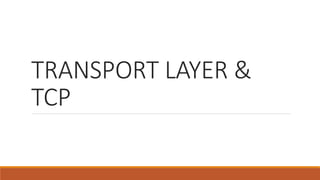
TRANSPORT LAYER ppt.pptx
- 2. CONTENTS •Introduction •UDP header format •Per-Segment Checksum •TCP: Connection management •Reliability of data transfer •TCP Flow control & congestion control •TCP Header Format
- 3. INTRODUCTION • It is recognized in OSI as well as TCP/IP model • It is responsible for source to destination delivery of entire message • Transport layer ensures that the whole message arrives intact and in order, overseeing both flow and error control at source as well as destination level • Transport Layer is responsible for delivery of entire message from one process running on source to another process running on destination.
- 4. UDP Header Format •The transport layer is represented by two protocols: TCP and UDP. •UDP is a part of the Internet Protocol suite, referred to as UDP/IP suite. Unlike TCP, it is an unreliable and connectionless protocol. •So, there is no need to establish a connection prior to data transfer. •The UDP helps to establish low-latency and loss-tolerating connections establish over the network. •The UDP enables process to process communication.
- 5. UDP Header Format •UDP header is an 8-bytes fixed and simple header, while for TCP it may vary from 20 bytes to 60 bytes. •The first 8 Bytes contains all necessary header information and the remaining part consist of data. •UDP port number fields are each 16 bits long, therefore the range for port numbers is defined from 0 to 65535 •Port number 0 is reserved • Port numbers help to distinguish different user requests or processes.
- 6. UDP Header Format • Source Port: Source Port is a 2 Byte long field used to identify the port number of the source. • Destination Port: It is a 2 Byte long field, used to identify the port of the destined packet. • Length: Length is the length of UDP including the header and the data. It is a 16-bits field. • Checksum: Checksum is 2 Bytes long field. It is the 16-bit one’s complement of the one’s complement sum of the UDP header, the pseudo-header of information from the IP header, and the data, padded with zero octets at the end (if necessary) to make a multiple of two octets.
- 7. Per-Segment Checksum • UDP Checksum calculation is similar to TCP Checksum computation. It’s also a 16-bit field of one’s complement of one’s complement sum of a pseudo UDP header + UDP datagram. • Here the checksum includes three sections: a pseudo header, the UDP header, and the data coming from the application layer. • The pseudo header is the part of the header of the IP packet in which the user datagram is to be encapsulated with some fields filled with 0s If the checksum does not include the pseudo header, a user datagram may arrive safe and sound. However, if the IP header is corrupted, it may be delivered to the wrong host.
- 8. Per-Segment Checksum • Sender side: • It treats segment contents as sequence of 16-bit integers. • All segments are added. Let's call it sum. • Checksum: 1's complement of sum.(In 1's complement all 0s are converted into 1s and all 1s are converted into 0s). • Sender puts this checksum value in UDP checksum field.
- 9. Per-Segment Checksum • Receiver side: • Calculate checksum • All segments are added and then sum is added with sender's checksum. • Check that any 0 bit is presented in checksum. If receiver side checksum contains any 0 then error is detected. So the packet is discarded by receiver.
- 10. TCP: Connection management Connection establishment is performed by using the three-way handshake mechanism. A three-way handshake synchronies both ends of a network by enabling both sides to agree upon original sequence numbers. This mechanism also provides that both sides are ready to transmit data and learn that the other side is available to communicate.
- 11. Reliability and Data Transfer It uses a checksum to detect errors. The receiver sends acknowledgement message if the message is complete, and if the message is incomplete, it sends a negative acknowledgement message and requests the data again. Four functions of reliable data transfer are:- Receive data Encapsulate data prior to sending Unencapsulate data upon receipt Send data
- 12. TCP Flow control Flow control deals with the amount of data sent to the receiver side without receiving any acknowledgment. It makes sure that the receiver will not be overwhelmed with data. It's a kind of speed synchronization process between the sender and the receiver.
- 13. Congestion Control A state occurring in network layer when the message traffic is so heavy that it slows down network response time. Imagine a bucket with a small hole in the bottom . No matter at what rate water enters the bucket, the outflow is at constant rate . When the bucket is full with water additional water entering spills over the sides and is lost. Similarly, each network interface contains a leaky bucket and the following steps are involved in leaky bucket algorithm: 1. When host wants to send packet, packet is thrown into the bucket. 2. The bucket leaks at a constant rate, meaning the network interface transmits packets at a constant rate. 3. Bursty traffic is converted to a uniform traffic by the leaky bucket. 4. In practice the bucket is a finite queue that outputs at a finite rate.
- 15. GROUP • UTKARSH LODHI • SUDHIR GEED • SRAJAL JAIN • ROHIT RAGHUWANSHI • ROHAN MAHAJAN • ROOPALI BHASKAR • YATI VISHNOI • SATYA PRAKASH SINGH RATHOR • RIYA JAISWAL
- 16. THANK YOU